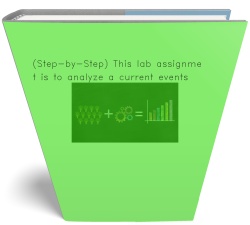Term project Written work You should submit your project in the form of a paper that describes the dataset,
Term project
Written work
You should submit your project in the form of a paper that describes the dataset, the research question, the analyses you carried out, the results of these analyses, and the discussion. You should include your SPSS output as tables or figures, either in the Appendix or in the text (for the most important ones only). You should clearly label and edit all output to remove non-essential portions. Do not simply tack on a pile of output through which I will have to navigate to find the relevant analyses! As a general rule, do not include any output that you do not mention, describe, or discuss in the body of the paper.
The quality of the written report will figure prominently in the grading. That is, to some extent, I will evaluate your work based on what I would expect from a journal article or research report. You may choose to deviate somewhat from the following outline, however.
Format -- APA publication style – strictly enforced!!!
- Use headings for each (sub)section consistently and effectively to communicate the structure and content of your ideas.
- Make it easy for me by referring to a specific page, table, figure, etc. in the text to indicate where the relevant information is.
- Cite sources (where appropriate) in the text, putting bibliographic sources in a References section at the end (before the Appendix).
Title page
- Include the following: Title, Name(s), Class, Instructor, and Date.
Abstract
- Summarize (in about 120 words) the purpose or goal of your work, and the results and what they mean, in substantive rather than statistical terms.
- Be brief and to the point; make it interesting.
Introduction
- Because there will be notable variability in the amount of background information available with the data sets, there will necessarily be variability in the levels of detail appropriate for the analyses.
- Background reading in the applied topic area may be useful.
- Begin with a statement of the research question to be investigated then introduce the data.
-
Following the introduction of the question, try to provide motivation for the analyses to follow such as:
- What kind of data is relevant to studying this question?
- What limitations are there in the data at hand?
- What sort of problems should one watch out for?
- Which variables might be expected to be relevant predictors? Why?
Method
- Describe here the methods and models used to analyze the data.
- Identify the criterion and predictors.
-
If necessary, explain why the methods are appropriate and how you looked at the data to examine assumptions, justify transformations if needed, etc.
- Be specific: For example, "This variable was log-transformed in order to achieve a linear relation," rather than "Some variables were transformed."
- Omit description of general aspects of statistics; assume your reader knows what a multiple regression analysis is.
- You may not have any explicit hypotheses, but you should indicate which variables you expect to be useful, relevant, or important predictors.
Results
- Present the results of your analyses simply and clearly; in order to do that, use graphical displays, tables, and discussion.
- Undigested computer output is not appropriate here!
- However, you may find useful to refer to figures, tables, or labeled points in computer output in an appendix.
- Include descriptive statistics (e.g., range of scores, mean, standard deviation, etc.).
- Do not write out formal tests of hypotheses as you would on an assignment.
Interpretation and discussion
-
Describe the scientific and statistical issues raised by the results described in the preceding section; for example:
- Does the prediction equation make sense?
- What do the signs and magnitudes of the regression equations mean?
- Summarize (again) your conclusions about the scientific question and back up your assertions with references to your Results: graphs, tables, etc.
- Make suggestions regarding further analyses or other data to be collected.
Appendices
- You will probably want to include at least one appendix logging the details of the computations.
- You should trim, annotate, and label the output (e.g., Figure 1, Table 10), and you should refer to it in the text (e.g., "see Table 2").
- You do not need to include the raw data .
- Note that you should summarize or compress (i.e., by deleting uninformative stuff) the output where possible, rather than just inserting it whole, especially where it deals with subsidiary issues.
Task (I will give you more information in a couple of weeks)
- Choose one of the datasets and carry out appropriate descriptive and multiple regression analyses.
- Consider this as a real research problem, involving data which may be messy and that you have to try to understand and summarize.
-
I will
suggest certain research questions and analyses; if you wish, you may propose your own questions and carry out somewhat different analyses
.
- Choose a research question that makes use of multiple regression analysis ; identify a few (i.e., two to four) sensible predictors based on the research question.
-
Preliminary analyses relevant to multiple regression may include:
- Look at the individual variables and make scatter plots.
- Consider whether you should transform any of the predictors.
- Examine the variables for wild observations (e.g., outliers) or other evidence of weirdness.
- Carry out complete a linear regression analysis of your selected criterion on the predictors.
- Interpret and discuss the results, including the pattern of residuals.
SPSS Tips
- In preparing your report, you will probably find it most convenient to save your outputs from SPSS in your home directory, and copy/paste portions into your document.
-
In order to do that:
- Select the region from the Output Window by dragging the mouse.
- Select Edit – Copy Object.
- Go to your word processing document, select Edit -- Paste (usually Ctrl-V).
Deliverable: Word Document


![[Step-by-Step] Project 7 : The ANOVA While is school, students [Step-by-Step] Project 7 : The ANOVA While](/images/solutions/MC-solution-library-80435.jpg)



![[Steps Shown] In this lab, you will collect and organize data, and [Steps Shown] In this lab, you will](/images/solutions/MC-solution-library-80439.jpg)
